Seventh example.
In October of last year I went to see Ulrike Ottinger’s film Prater (2007) at the Harvard Film Archive. The film got me in the places that thoughts of the old Coney Island and its slow destruction get me in NYC every summer. (My mother’s Brooklyn childhood; my grandfather’s photographs of Coney and Canarsie; my own memories of maybe three visits to Luna Park grafted onto what I imagine to have been their attachment to the place.) Greasy, noisy, exciting, slightly dangerous machines, freakshows and old carney skank, chromolithography, family entrepreneurial sagas, the eternal impassable watershed of the war… When I asked, Ottinger insisted that she never meant the film to be nostalgic. That may be so, but it certainly shows and elicits a certain nostalgia, for what Ottinger called (something like) the supersession of mechanical by electronic entertainment. Nostalgia for the machine: again, for the technology before last, which, at least, could be smelled, touched, tasted, heard – not only seen. – They still have freakshows at Coney Island. I’ve been to one of them twice – “Sideshows By the Seahore.” Good stuff, but even if those nails are really going into his nose and those swords down her throat, it’s a simulacrum, a museum of itself: as at Colonial Williamsburg, the performers, in period costume, talk of what “they” used to do. Perhaps this is not unlike the dealer at the 2005 Armory photography show I saw showing recent Daguerrotypes, Platinotypes, Cyanotypes, Calotypes, gum bichromate prints… the whole alt-process thing a clear reaction to digital.
A question.
Why, given so much work in found-footage cinema, is there, apparently, so little comparable found-audio music? I should be more precise: sampling and scratching are, certainly, found-audio music; but the only example I’ve found that revives historical, “orphan” sound, elegiac or not, is John Schott’s Shuffle Play: Elegies for the Recording Angel (2000), which frankly rather bores me. What I’d maybe like is a Beastie Boys or DJ Shadow remix of old gospel and vaudeville and Edison cylinders (Tom’s Boutique)... Are the careful new Dust-To-Digital and Revenant compilations really found-audio compositions, or are they the mixtapes preceding found-audio mash-ups yet to come? The odd thing is that in the early days of montage, sound montage was not far behind image montage, and even the latter was thought of musically: Walther Ruttmann made his visual “symphony” of Berlin in 1927, then the “sound montage” film Melodie der Welt in 1929; Dziga Vertov began with experiments in sound montage as early as 1916, moved from there to visual montage, then returned to sound with Entuziazm, in 1931. I can’t imagine that the difference is due simply to the fact that this was not found-footage cinema, nor elegaic.


How do you distinguish between samples and historical "found" sound? It seems to me that a lot of the samples that DJ Shadow, for example, uses are indeed found sound, ingrained with the texture of its history (to begin with, the noise of worn vinyl), and imbued with nostalgia for a certain mythical view of the '60s or early '70s. The whole rare groove thing, after all, is about historical retrieval. There are also Moby's remixes of old gospel recordings (those were his biggest hits, after all). And, umm, Revolution no. 9? From the classical side, there's Pauline Oliveros' gorgeous "Bye Bye Butterfly", Pierre Henry and Pierre Schaeffer, some of Steve Reich's pieces such "Different Trains," etc etc etc.
ReplyDeleteGotta check that stuff out, I don't know any of it (excepting the Beatles), and you might be right; or, in any event, I'll need to sharpen my definitions. Could be I'm looking more for miners in the mother lode that most interests me, which is roughly 1920-1940. Is the rare groove thing as historical retrieval also at least sometimes elegiac? -- I did want to riff on the snap-crackle-pop fetishism of vinyl buffs -- just found some more on the Dresden Dolls' first album, matching their love of my own mother lode -- but I don't have those thoughts quite in order.
ReplyDeleteBy the way, by "Rare groove" here I mean not just the obscure vinyl records sought by collectors, but music (growing out of acid jazz/ambient/trip hop/lounge) made with such sounds, and intended to extend that sound world, if you will. And from that point of view, yes, rare groove is positively dripping with elegiacism and nostalgia. Exhibit number one:
ReplyDeletehttp://www.youtube.com/watch?v=InFbBlpDTfQ&ob=av2n
Moby: http://www.youtube.com/watch?v=dBCkoDJkIOc
ReplyDeletePauline Oliveros: http://www.youtube.com/watch?v=G9GJCL3PpYA
(an excerpt of the piece that contains the section I was thinking of)
More British rare groove:
http://www.youtube.com/watch?v=TAMjpgRZORk
(using period samples to create a kind of dream version of late '60s soul)
etc etc